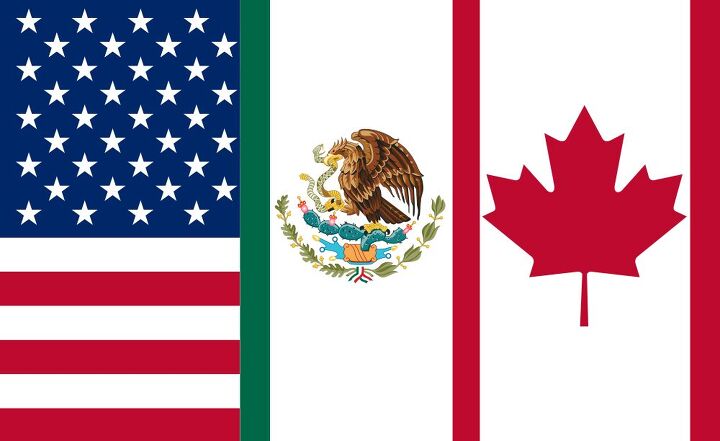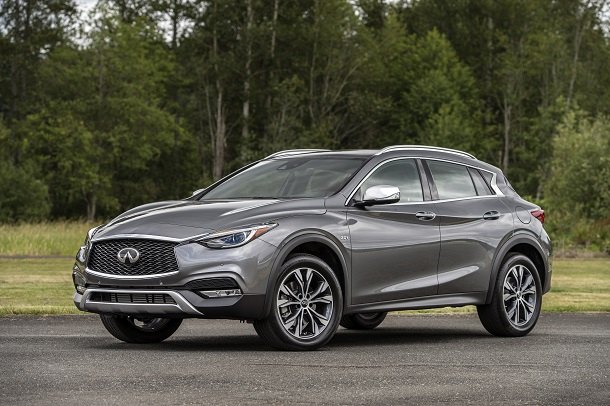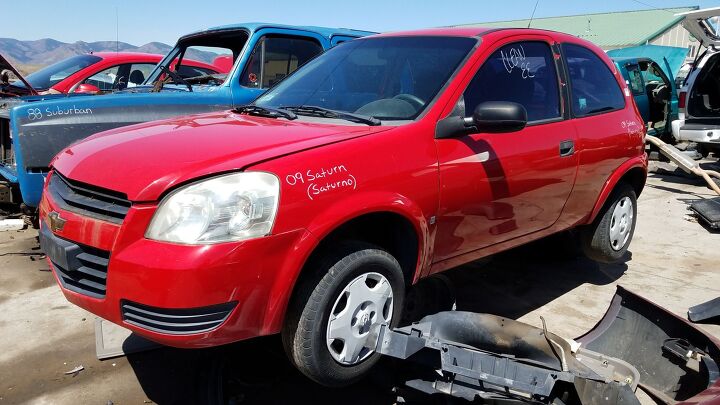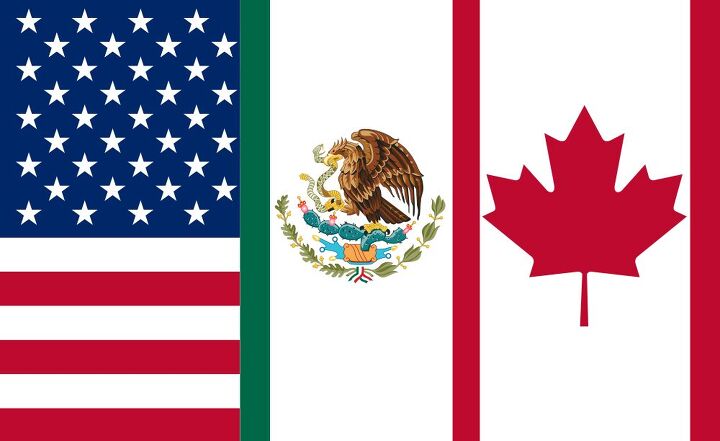#Mexico
Apparently, Everyone Negotiating NAFTA Is a Child
If you’re anything like this author, you’ve probably abandoned discussing the North American Free Trade Agreement in your personal life. That’s not because it stopped being important, but rather due to the fact that none of the three countries involved seem capable of making any sort of progress.
Presently, the United States and Mexico are focusing on rules associated with automotive production. However, after two days of non-stop negotiation, Mexican Economy Minister Ildefonso Guajardo said the two sides haven’t resolved their differences on the pending issues. Now Mexico says it won’t consider further negotiations until Canada agrees to a deal.
Here’s where things get remarkably shitty. Canada has already explained that it’s waiting for the U.S. and Mexico to strike a deal of their own. “If they can resolve their differences on [automotive trade], then I think we can move ahead and have the three of us talk about some of the other issues that affect all of us,” David MacNaughton, Canada’s ambassador to the U.S, said in an interview earlier this month.
Three's Company, Too? Canada Returning to NAFTA Dance As U.S. and Mexico Approach Auto Deal
Canada says it could rejoin the NAFTA discussion, just as the United States and Mexico approach an agreement on automobiles. The two nations engaged in bilateral negotiations a little less than a month ago, seemingly making positive headway on a trade deal.
With President-elect Andrés Manuel López Obrador assuming office in December, it’s in the United States’ best interest to close a deal as soon as possible. It’s assumed the man, frequently referred to as “AMLO,” will make sweeping changes to the Mexican government. However, he also promises to join forces with several smaller parties from both the right and left to create a coalition aimed at rooting out corruption. The resulting level of uncertainty has many fearing difficult Mexican policy changes and trade negotiations in the future, effectively forcing a restart of NAFTA talks.
According to David MacNaughton, Canada’s ambassador to the U.S., the duo are close to finalizing a deal on automotive manufacturing. If so, the Northern nation is prepared to rejoin negotiations.
Be Thankful the U.S.-Market Nissan Kicks Has Standard Stability Control
A reader sent us a link to a Mexican handling test of Nissan’s new, front-drive Kicks crossover, and one glimpse of the vehicle’s “moose test” will have you on your knees, thanking the deity of your choice for electronic safety nannies.
We all know that high-riding vehicles suffer from an inherent top-heaviness, born of a high center of gravity and compounded by long suspension travel. As SUVs grew in popularity in the ’90s, a slew of alarming videos arose showing popular SUVs flipping or riding on two wheels while swerving sharply to avoid a object, then recovering. The moose test is the ultimate test of a vehicle’s stability, and it’s the test most likely to see a tall vehicle — thanks to rapid weight transfer — roll more than it yaws. Sometimes with disastrous results.
The advent of electronic stability control was a godsend for these types of vehicles, helping overcome much of the roll and yaw, but, while it’s mandated in the U.S., Canada, and Europe, in some markets it’s absent from certain models or trim levels. Take a look at what happens without it.
A New Headache for Automakers: Train Robberies
Let’s face it: there’s few things more romantic than trains, and robberies of said trains have formed the backbone of great novels and films for over a century. The modern reality is not quite Butch Cassidy and the Sundance Kid, however. It’s impoverished and not quite moral bandits piling rocks onto tracks in a bid to derail a train, then making off with whatever they can sell. No dynamite and bank vaults here.
In Mexico, the rising popularity of such robberies is proving an expensive headache for automakers shipping cars from Mexican assembly plants.
Report Points to Product Turmoil in the Nissan-Daimler Partnership
A report in a Japanese business publication claims the partnership that gave us the Infiniti QX30 crossover — built on the same MFA platform as the Mercedes-Benz GLA — won’t yield a compact Infiniti luxury car, as was planned.
This isn’t a case of bad blood between the two automakers, however. The United States just isn’t a ripe target for such a vehicle anymore, apparently, and the vastly uncertain trade situation doesn’t help.
Chevrolet Blazer Bound for Mexican Plant, UAW 'Disappointed'
The new Chevrolet Blazer is the hot-ticket auto creating the most buzz right now, but it’s also generating mild controversy. Many who remember the original were more than a little disappointed seeing the name affixed to a unibody crossover with front-drive origins. While mainstream shoppers aren’t likely to mind, former Blazer owners aren’t thrilled with General Motors’ decision.
It’s probably more financially viable for the automaker to do it this way. GM can definitely serve most customers for less money. But you get the sense that they’ve watered down the automotive broth to stretch the C1XX platform as far as it will go. At least it means more jobs for Americans, though, right? Well, not exactly.
Bet You Forgot Today Was the NAFTA Deadline
If you forgot today was the deadline for finalizing North American Free Trade negotiations, don’t worry, so did practically everyone else. In fact, the whole affair is starting to feel like that old car that’s been sitting in your friend’s yard for far too long. He keeps telling you he’s going to fix it up and make it better than new. “This is the summer,” he says. But you know he’s just going to keep mowing around it while it continues to rust and collect mice, so you’ve tried to push it out of your mind.
Like the restoration, the entire concept of a deadline for the trade deal is rather arbitrary at this point. NAFTA’s initial target date for an agreement between the three countries was March 31st, roughly one year after negotiations began. The May 17th deadline was claimed by U.S. Speaker of the House Paul Ryan, who said Congress had to be notified under the Trade Promotion Authority statute.
“We need to receive the notice of intent to sign soon in order to pass it this year,” explained Ryan’s office. “This is not a statutory deadline, but a timeline and calendar deadline.”
Basically, Congress wants to influence the president and NAFTA negotiators to conclude talks swiftly and reach an agreement before midterm elections. But Mexican officials warned everyone not to get their hopes up. “The possibility of having the entire negotiation done by Thursday isn’t easy, we don’t think it will happen by Thursday,” said Mexican Economy Minister Ildefonso Guajardo earlier this week.
Junkyard Find: 2009 Chevrolet Chevy
In all of my 35 years of exploring junkyards in the western United States, I had never found a Mexican-built, Mexican-market car until a few weeks ago, when I spotted this General Motors de México-manufactured 2009 Opel Corsa in a Denver-area self-service wrecking yard.
Team Trump Eases Demands on NAFTA's Regional Auto Content
The United States is softening the contentious automotive content requirement mandates pushed by the Trump administration as part of NAFTA renegotiation talks. While the demand is only one of many asks coming from the U.S., both Canada and Mexico said forcing 85 percent of a vehicle’s overall content to be sourced from the three countries (in order to side-step tariffs) was a nonstarter. Over the past year, the issue became a major sticking point in the trade talks — hindering progress and possibly dooming them to failure.
While Trump’s intent was to bolster domestic employment by incentivizing North American parts suppliers, automakers expressed concerns and noted it was often difficult to reach the current threshold of 62.5 percent.
The United States has now proposed applying the new content requirement only to major components (like a vehicle’s powertrain) while leaving fasteners (nuts, bolts, etc.) alone. As an automobile is made up of tens of thousands of individual parts, deciding what should and should not be counted will make a big difference. Still, some manufacturers are likely to have difficulty meeting the proposed content requirement on critical engine components.
Slow-Moving NAFTA Talks Could Be Further Hampered by Mexico's Next President
With NAFTA negotiations finally progressing a bit, now would be the perfect time for something to bring up another potential hurdle and ruffle everyone’s feathers. This time, the prospective cataclysm stems from Mexico, and has manifested itself as one man — presidential frontrunner Andres Manuel Lopez Obrador, known colloquially as “AMLO.”
Business interests and NAFTA advocates are fearful the leftist candidate could chuck a wrench into the trade policy by adopting a hardline stance opposing the White House’s plan to redefine the agreement to favor the United States. Lopez Obrador is a long-time proponent of social programs that help vulnerable members of society. However, many criticize him for being a populist with socialist ideals that do not serve the financial well-being of the country at large.
While this is debatable, winning Mexico’s July 1st election could see him push back hard against U.S. trade proposals, stalling progress.
Michigan to Mexico: Ford's Upcoming Electric Crossover Moves House
In public, automakers talk a great game about the industry’s electric future. The money poured into the development of electric vehicles is necessary, they say, in order to stay competitive in a changing marketplace. It wasn’t long ago that Ford claimed 100 miles of range was just fine for an EV model; not long after, following the introduction of the 238-mile Chevrolet Bolt, it announced the development of an EV crossover with far greater (300-mile) range.
Whether or not electric power becomes the dominant propulsion source in the United States remains to be seen, but no automaker can be seen resting on its laurels, shunning the most hyped technology. That doesn’t mean a company can’t be realistic about it, though.
Ford’s electric crossover, expected to roll out of Michigan’s Flat Rock assembly plant in 2020, will instead roll out out of a factory in a much warmer (and cheaper) locale.
Toyota Pares Down Mexican Plant Plans, but 100,000 Extra Tacomas Are Still on the Way
The only thing better than two plants producing North America’s hottest-selling midsize pickup is three plants churning them out. That’s a big part of Toyota’s plan to stay ahead of General Motors and future competitors like Ford in the small yet vital segment.
Despite making every effort over the past year to build more Tacomas at its Tijuana, Mexico, and San Antonio, Texas, assembly plants, those facilities are maxed out, leading to Toyota’s August decision to punt Corolla production (initially bound for a planned Guanajuato, Mexico, plant) to a new $1.6 billion U.S. facility in the near future.
On paper, the Guanajuato plant aimed to produce 200,000 Corollas per year. Well, those plans have changed. Toyota now says it will drop its investment in the plant from $1 billion to $700 million, with production capacity dropping by half. That still means 100,000 extra Tacomas for a hungry customer base.
Obligatory NAFTA Update: Mexico and Canada Reject U.S. Proposals as Talks Wrap Up
As the fifth round of NAFTA talks come to a close, Mexico and Canada continue to reject the United States’ demands regarding automobiles, diary, dispute panels, government procurement and the sunset clause. Among the more recent automotive proposals kicking up dirt is the U.S.’s wish to include steel in NAFTA’s tracing list and increase the mandatory local content of every car built in North America. The attempt has annoyed foreign officials and left the industry fretting about increased production costs and complexity.
The increasingly tense nature of the talks has left many wondering if President Trump will make good on his earlier threat to leave NAFTA. However, plenty of analysts are of the mind that a deal will eventually be reached between the three countries.
Ending NAFTA Could Cost U.S. 50,000 Auto Jobs: Study
Automotive trade groups have issued warnings about the scrapping of the North American Free Trade Agreement all year. In January, the Center for Automotive Research claimed killing NAFTA could result in the elimination of at least 31,000 auto jobs within the United States. This week, a new study sponsored by the Motor Equipment Manufacturers Association upped that estimation to around 50,000.
With early negotiations not going particularly well at the moment, the new tally serves as a potential warning. If NAFTA is abandoned, North American countries would all likely revert to rules dictated by the World Trade Organization, resulting in higher tariffs from all sides.
While 50,000 fewer jobs is the upper echelon of what could be expected, a few things have to go wrong for it to reach that point. First, Mexico and Canada would have to revert to pre-NAFTA tariff levels — which were comparably higher than the United States. If so, manufacturers would almost assuredly begin sourcing more parts from the same countries where the vehicles are assembled, and gradually move production to lower-cost regions like China.
U.S. Is Intentionally Sabotaging NAFTA Trade Talks, Officials Claim
President Donald Trump entered into office threatening to abandon the North American Free Trade Agreement if the United States was not given a better deal immediately. But, after negotiations began, it looked as if his ultimatum would be unnecessary.
Now, U.S. officials involved in NAFTA negotiations are being accused of making proposals on issues Mexico and Canada have said they would never agree to. Are these bold negotiation tactics being used to place the U.S. in a better position for future issues, or are trade arbitrators intentionally trying to sabotage talks so Trump can make good on his promise to leave the agreement?






























Recent Comments